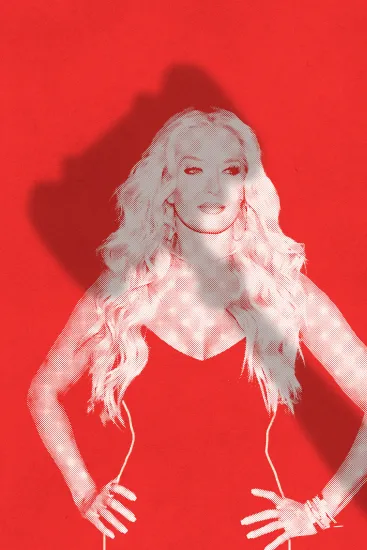
Illustration by II
In December 2015, Erika Jayne Girardi made her debut on hit reality TV series The Real Housewives of Beverly Hills.
Her tagline? “I’m an enigma wrapped in a riddle . . . and cash.”
A blonde 44-year-old with glossy lips, Erika explained during her first season that she had met her much older husband — “uber-famous lawyer” Tom Girardi — when she was a cocktail waitress at a restaurant he frequented. She gave him her number, and the rest, she says, was history.
Her husband, a personal injury attorney, was already famous in his own right: His winning case against Pacific Gas & Electric was the inspiration behind the film Erin Brockovich.
The Girardis lived an opulent life: Court documents claim Erika spent $40,000 per month on her look alone, and Tom had a standing daily reservation for an exclusive table at Morton’s Steakhouse in Los Angeles. The duo allegedly owned two private jets in addition to multiple homes.
But all the money, the glitz, and the glamour evaporated in 2020, in no small part because of an esoteric asset class: litigation finance. Defaults on loans Girardi had taken out for his law firm cascaded into a series of lawsuits, a bankruptcy filing, and a divorce for Erika and Tom.
“It was a snowball going downhill that went faster and faster and got bigger and bigger,” says Andrew Goodman, the lawyer who filed an involuntary bankruptcy petition against Girardi. “He was playing a shell game and keeping each [lender] at bay. It all ended up crumbling down on him.” Here’s how it happened.
The loan was secured on cases Girardi’s law firm, Girardi & Keese, was fighting against Shell Oil, Riverside Cement, GlaxoSmithKline, Eli Lilly, and other cement and drug companies. If Girardi won those cases, Stillwell Madison would receive a cut of his firm’s winnings.
For the uninitiated, litigation finance is a lending business that has gained popularity among institutional investors in recent years. Litigation finance firms lend money, either to law firms or their clients, to fund cases that the litigation financiers believe will garner big returns. When lawyers win the cases, the litigation funders receive some of the earnings.
“As the market has grown, it has gained strength because it really does work,” says Rebecca Berrebi, who runs litigation finance consultancy firm Avenue 33. “It can promote justice and raise money for investors and litigants. And by the way, it’s really amazing for law firms because it secures payments while still letting lawyers take a piece of the upside.”
There are two ways for law firms to access financing, Berrebi explains. They can offer up a portfolio of their cases to a funder, whose returns are secured against all the cases. If one or two lose, the lender can still get a “huge return,” she says. The other option is to access a loan for a single case.
But in this case, Girardi allegedly did not return the proceeds to his litigation funders. Instead, Stillwell Madison claims that he kept some of the money for himself and his wife “in order to sustain their lavish lifestyle and maintain their glamorous public image.”
And so, in 2018, Girardi & Keese allegedly defaulted on the loan payments to Stillwell Madison. The two firms worked out a deal, court documents show. Girardi would pay $500,000 per month from October onward, and the loan would be repaid in full by the following year. What Stillwell Madison claims it did not know, however, was that weeks earlier, Girardi & Keese had defaulted on a separate loan from another funder, Law Finance Group. Stillwell Madison’s contract required Tom Girardi to give notice to Stillwell if his firm had any other defaults.
But it would be a few more years before the depth of his financial stress was brought to light.
Nearly a dozen families who had lost loved ones on the Lion Air flight hired Girardi’s law firm to represent them in a case against Boeing, the airplane’s maker. Their case went well: In early 2020, the clients settled the lawsuit, and court documents suggest the proceeds were transferred from Boeing to Girardi & Keese.
Except the families never received the money.
Meanwhile, Girardi allegedly was only sporadically making his monthly payments to Stillwell Madison. Eager to get the money back, the litigation funder filed a lawsuit against Girardi, his wife, and his law firm in May 2019. At the time of the filing, Girardi allegedly still owed Stillwell almost $3.5 million.
Stillwell Madison wasn’t the only lender nipping at Girardi’s heels. The celebrity attorney had allegedly taken out more than one of these loans, sometimes pledging the same collateral to different lenders. This became public knowledge only years after the fact, all thanks to a declaration in a 2021 bankruptcy case filed against Girardi.
Although this practice — pledging the same assets for multiple loans — recently came up in the high-profile case UMB Bank filed against Citigroup and Revlon in August 2020, it is not common in the litigation finance industry.
Soon after the plane crash case was settled, law firm Edelson began the process of structuring the settlements that would ultimately go to the affected families. After months of reaching out to Girardi & Keese employees, Edelson says it learned that the law firm had received the money from Boeing.
Then Edelson dug deeper, asking: “Have the clients received their proceeds from the settlements?” The answer, the firm found, was complicated.
According to a lawsuit later filed against the Girardis and Tom’s law firm by Edelson, Girardi and his litigation finance lenders had set up “intercreditor agreements,” which presumably would direct any money in Girardi’s bank accounts to those lenders. The result, according to the complaint, was that Girardi and his law firm “directed Lion Air client funds, and money otherwise owed to third parties like Edelson, to lenders including . . . California Attorney Lending in order to stave off these creditors.”
As Goodman tells it, Girardi’s “income on cases became insufficient to pay the bills.”
He adds, “I know that at one point, he had upwards of 30 lawyers, and slowly they all just left. At the end there was nobody left.”
Pressure on Girardi began to mount. On election day 2020, his wife quietly filed for divorce, according to news reports at the time. A month later, Edelson sued them both, along with Girardi & Keese, two of the litigation finance firms, and others.
The lawsuit alleges that Tom Girardi had been “embezzling the proceeds of settlements that should have been directed to his clients — including, as the basis for this complaint, the widows and orphans who lost loved ones in the tragic crash of Lion Air Flight 610 — in order to continue funding his and Erika’s lavish Beverly Hills lifestyles.”
Says Goodman, “He made the cardinal sin of taking money out of his client trust account and using that with the hope that his next victory could replace it.”
The lawsuit also went after Stillwell Madison and California Attorney Lending, alleging that they had structured an intercredit agreement among themselves.
The case quickly garnered attention. Lawyers were eager to follow a high-profile case targeting one of their own, and the Real Housewives fan base fervently pored over court records, sharing their findings on podcasts and social media.
Two weeks later, the followers had another set of records to examine: bankruptcy filings.
Goodman filed an involuntary petition for Chapter 7 bankruptcy protection against Girardi & Keese. “The idea is that you have assets spread all over the place,” he says of the process. “You want to get them under the same umbrella. Otherwise, you’d just have a continuous race to the courthouse.”
He filed the petition late at night. Within 20 minutes, he received 25 request forms from people looking to receive automatic updates on the case. Goodman recalls that one of the early hearings on Zoom — a relatively banal meeting to appoint interim trustees — had more than 70 participants. “Other than myself, there were two people that spoke,” he says. “It just showed me what the interest of it was.”
This is not unprecedented behavior from Housewives fans. In late March, the first hearing in a Salt Lake City housewife’s alleged wire fraud case was delayed after too many people joined the videoconference, causing technical difficulties.
Bankruptcy cases can halt certain other civil case proceedings, including some of the ones Girardi is involved in. The list of Girardi’s creditors is long and includes not only the families that have yet to receive their payouts from the Lion Air lawsuit, but also the litigation finance firms that lent him money.
A declaration in the bankruptcy case, filed on December 24, details Girardi’s alleged practice of pledging the same collateral for multiple litigation finance loans.
According to litigation finance experts, this isn’t something that should happen. “What you do not see is one case or a portfolio of cases secured against investors who don’t know about each other,” Berrebi notes.
At minimum, it’s something that litigation funders can avoid. “It should really be in the contract that they have a first-priority lien or security on the cases,” Berrebi says. “It should be very clear that I’m funder A, my return is going to be x percent of this case. My money comes out first.”
Dai Wai Chin Feman, director of commercial litigation strategies and corporate counsel at litigation finance firm Parabellum Capital, agrees.
“Whether you have a first lien on the collateral is a paramount consideration because you don’t want to end up in a dispute where people are fighting for the same asset,” Chin Feman says.
But, Berrebi points out, there’s an exception for alleged fraud. She explains that it is possible to structure loans so that a situation like the Girardi & Keese case doesn’t happen.
“I don’t know if there’s a way to keep it 100 percent lockbox-safe,” Berrebi says. “But one way to do it is to insist in your documentation that any money received has to be sent to an escrow account. The money cannot be taken out of such account without joint signatures or can be taken out just by the funder.”
The case against the Girardis and the litigation finance firms is expected to last for a while. “I think it could take at least another couple of years because you have all the investigations, all these petty lawsuits that have to go to trial or have to be resolved,” Goodman says.
But as the cases wind their way through the courts, Erika Girardi is back on-screen. The latest season of The Real Housewives of Beverly Hills hinges on the surprise divorce and the subsequent legal drama, and a made-for-Hulu documentary called The Housewife and the Hustler premiered on June 14.
Although some news stories called her decision to remain on the reality series a “risky move,” Erika Girardi maintains on the show that she did not know about her husband’s legal woes. Their attorney declined to comment. Their attorney declined to comment. Bravo did not return an email seeking comment.
Her new tagline pays homage to the diminishment of her wealth: “The strongest substance on Earth isn’t diamonds,” Erika Girardi says. “It’s me.”





